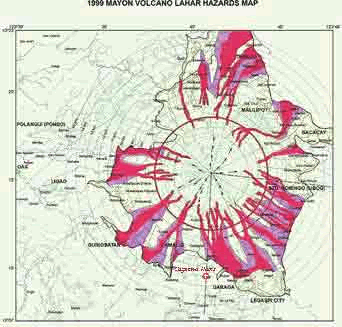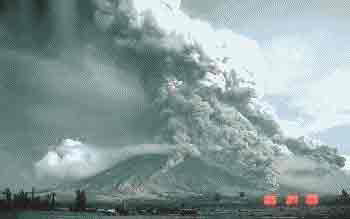|
Beauty and Horror of Mount Mayon The Philippines are laying in the shifting area of three earth plates, which push each another in different directions. These shifts cause tectonically disturbances. The largest zone of disturbance is situated in the North-South-direction of Luzon to Mindanao and here along this line most of the approximately twenty active volcanoes on the Philippines are situated. The most active however also the most beautiful volcano in this chain of volcanoes - is the Mount Mayon situated near Legaspi. The silhouette of his almost perfect triangle or cone form dominates the panorama the panorama of the eastern landscape of the province Albay. Even if the Mount Mayon with his 2462 meters is not particularly high, with a scope of approximately 130 kilometres it builds himself up like an outsized king Ubu in front of the observer, which gets the feeling to be very small. Steeply, the dark mountain-flanks fall into green coconut forests or fertile rice-fields. Mostly a crown of steam appears at the crater-edge and frequently in the late morning a white ring of clouds rises up the mountain, covering parts of the mountain. With the naked eye the observer can see the red-black coloured ravines of deeply rinsed forty canyons. According to prevalent opinion, the two young Scots Paton and Steward have been the first, which climbed the mountain in 1858. Today the climbing of the mountain in a 2 -3 days tour is still possible, even if the number of the official routes is reduced to only one on the south-west-side because of the dangerousness of the mountain. But it is strongly recommended to take the help of native mountain guides. Only a limited crater-access is possible. Jens Peters (1) respectively Jens Edelmann under www.vulkane.net/reportagen/repmayon.html
are giving useful information about the routes
and their possibly deadly risks (danger of getting lost in the in the
dead ends of the canyons at the mountain-foot / flooding of the Canyons
at rain / accident-risks through slippery steep-stages and rock falls /
poisonous steams). First the mountain climber will take his way by
following the rocky canyons, which can reach a wall-height of more than
100 meters and in which salts and sulphur is deposited. Up to 1800
meters a secondary jungle with areas of several meter high tulahib grass
is prevailing. The vegetation becomes more and more meagre. On the way
to the top a lot of lichen and huge molten boulders, that can reach
house-height can be seen. Finally, the mountain top appears as a
bald rock-desert with a badly rugged crater-edge decorated with clouds
of water and patches of sulphur deposits. Scientists have calculated
that the Mount Mayon is ejecting on average 745 tons of sulphur a day
into the air. Whereas the Pinatubo Volcano was exploding heavily only one time in 1991 after a very long time of silence, Mount Mayon is a continuously dangerous volcano. It is especially dangerous under the aspect that approximately 560.000 inhabitants (120.000 of it in the City of Legaspi, which is only 11 kilometres far from the crater) are living in its three danger zones. Taking advantage of the cooler climate thousands of farmers are cultivating on the fertile, but very dangerous slopes potatoes and vegetables like in Baguio. There are some indicator signs for an eruption: (a) an increase of seismicity, (b) ground tilt due to magma intrusion, (c) discolouration of the clouds of smoke from white to ash-grey, (d) increase in the volume of steam emission (e) crater-glow caused by rising magma, (f) rumbling sounds because of gas explosions, (g) rock-falls and landslides, (h) fissuring of the mountain (rare). These indicators are well observed by the vulcanologists, when they decide for one of the five levels of alarm. Vulcanologists are speaking from different types of eruption. A Strombolian eruption shows only a quiet emission of lava (e.g. 1978). In 1984 there was a vulcanian eruption, that means, there have been violent explosions and eruptions of pyroclastic flows. Extremely vehement explosions with continuous sustained ejections of pyroclasts marks the Plinian type of eruption (for example 1814). For the first time, an outbreak of the Mount Mayon was documented 1616 by Dutch seafarers. The history of the eruptions registered until today shows other fifty middle to heavy outbreaks in the following years:
The thesis, that the volcano has a stronger eruption all ten years is rejected by experts and also our statistics. The dates of eruption are in the middle and long-term not calculable. Roland Hanewald put it in a very pessimistic point of view like that: Vulcanologists are very pessimistic with regard to the unpredictable mountain. An America expert told me, that there are indications, that a big bang could happen there , including a complete collapse of the eastern half of the mountain. Besides other people some Germans took their residence there in the bleak terrain. Luck, good luck, for a long life may be wished to them. Perhaps the pure coincidence gives them some few years of mercy. (2) The recent eruptions of Mount Mayon arte also described in detail in the internet, e.g. under: http://volcano.und.nodak.edu/vwdoes/current_volcs/philippines/mayonvol.html Therefore, we restrict our description of the eruptions of the Mount Mayon Volcano to the heaviest outbreak in the year 1814 connected with the destruction of the town of Cagsayan, even if this historical Big Bang happened now almost 200 years ago and even if there are only few documents referring to this event. The inhabitants of Budiao established in 1587 the barangay of Cagsayan because they felt threatened at the old place by continuous outbreaks of Mount Mayon. From present point of view they moved into a rather moderated endangered zone, some 12 km away from the crater. In 1605 the inhabitants built up a first church, which they dedicated Nostra Signora De la Porteria . The place began to flourish quickly thanks of his merchants and the and the productive agriculture. The prosperity of the place did also attract not desired visitors so marauding pirates from the south and plundering Dutchmen (1636). Later the church was rebuilt again with engraved volcano-stones and bells decorated with gold- and silver-ornaments. But then the catastrophe-day came on the first of February 1814. Already in the preceding evening, the inhabitants registered seismic shocks. Padre Francesco Tuibino living in the more western situated place of Guuinobatan - described in 1816 the events of the following day as follows:
After
further seismic shocks in the morning the mountain disgorged from its
throat something like
And another eyewitness reports: At 8 o'clock in the morning , the mountain suddenly ejected a thick column of stones, sand and ashes, that quickly climbed up into the highest air-layers .. The sides of the volcano veiled themselves and disappeared from our looks. A fire-stream crashed from the mountain and threatened to destroy us .. Everybody fled and looked for the highest points. The tremendous noise of the volcano frightened everybody. The darkness increased. The fleeing persons partially were slain by down-falling stones .. The houses offered no protection because the glowing stones put them into fire .. By ten o'clock the down-falling of big stones stopped, then a sand-rain took place; at one thirty the rumbling decreased and the sky cleared up gradually. The ground was covered with corpses and injured persons .. The sight of the volcano was sad and dreadful, its earlier so picturesque, farmed slopes were covered with sand, awfully barren .. The coconut-trees were buried up to the treetops .. (4) On this catastrophe-day considerable parts of Albay and Guinobatan with the cities Camalig, Budiao and Cagsawa were completely or partially destroyed and burned by red hot lava-streams and the bombardment with hot rocks. In Cagsawa at 8.30 o'clock the priest ordered his server to ring the bells in order to warn the inhabitants about the eruption. Hundreds of inhabitants took refuge in the church with candles in the hand. However this was not a good option. The church room became a inescapable trap, because a lava-tongue quickly moved onto the church and covered together with ash-rain the church-building. The place of Cagsawa was erased and had to lament more than 1200 victims. Survivors erected a successor-church in Daraga. Today, only a weathered top of the belfry and some walls from the vicarage and convent house are remembering on the event of death and terror. Surrounded by green rice and grass fields the blackish ruin of the stable is raising its warning finger (Albrecht G. Schäfer) in front of the silhouette of Mount Mayon. The church tower reminds like an oversized tombstone of the dead persons and the beautiful dangerousness of the Mount Mayon. For Carlos Gegantoca (5) the ruins are a Philippine counterpart to the ruins of Pompeii. The mute remains of the church have not been touched over the centuries, although there have been plans from archaeologists and treasure-diggers (a rumour is reporting that there rich Spaniards escaped into the church) to dig out the church. Today the erased place of Cagsawa and its weathered ruins are part of a park and a highlight for tourists and their cameras. More than hundred visitors on average are registered each day. Some visitors have perpetuated themselves by scratching graffiti in the stonework (I was here). The place reachable from Legaspi or Daraga has been commercialized by the tourism. An entrance-fee has to be paid and numerous dealers and shops are offering orchids, pili-nuts, weaving products, art-objects and souvenirs for good prices. Whoever wants, can also rent an air-conditioned cottage, has the opportunity to amuse in a swimming pool or perhaps can listen the lecture of a spirit healer in the Social Hall. More contemplative persons may - every first Friday in the month - visit a mess in the evening, which is sometimes conducted by a bishop. The mess uses a half burnt, car-big volcano-stone as altar. May be that the priest is praising the grace and elegance of the Beauty Lady (magayon means in Bicol language beautiful), but we can be sure that he will also mention the fury like elementary power and violence of the Lady connected with the comment on the weakness and infirmity of human life. © Wolfgang Bethge, in 2003 (1) Jens Peters, Philippinen Reise-Handbuch, Bremen, 2002, S. 400 f (2) Roland Hanewald, Philippinen Abenteuer-Handbuch, Bremen, 1966, S. 372 (3) Quotation from: F. Jagor, Reisen in die Philippinen, Berlin, 1982, S. 71 (4) Quotation from: F. Jagor, Reisen in die Philippinen, Berlin, 1982, S. 70 (5) Carlos Santos Gegantoca, Inquirer News Service
|

